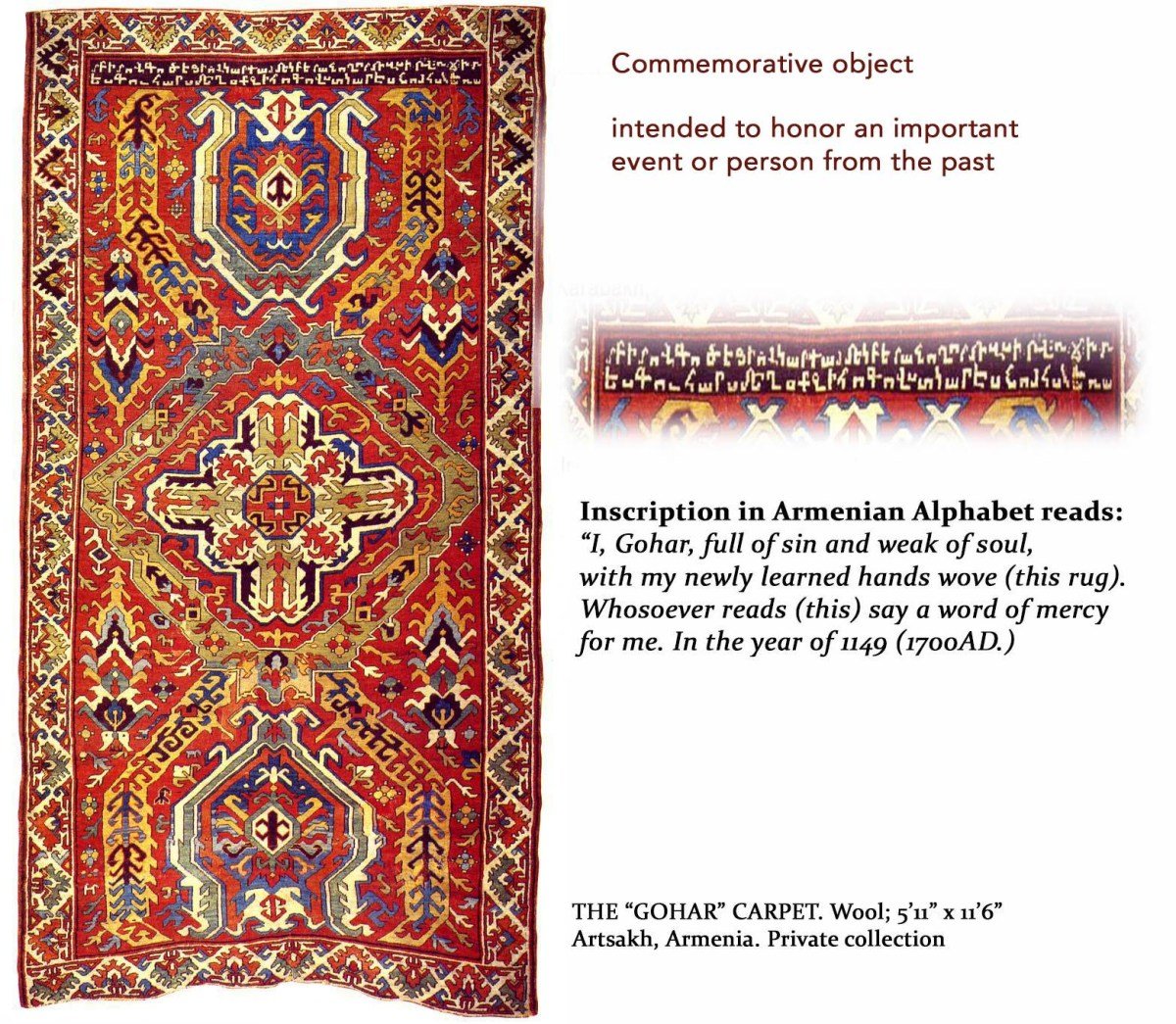
“I, Gohar, full of sin and weak of soul, with my newly learned hands wove this rug. Whosoever reads this, say a word of mercy to God for me. In the year 1149.” (Inscription in wool rug circa 1699)
Sometime between the years 1699 and 1700 in the mountains of the Caucasus, an Armenian woman by the name of Gohar wove a message for the future into the threads of a rug. The rug was to be donated to an Armenian church, and it was common practice for weavers to leave inscriptions in offerings including dates and names of weavers or patrons. These inscriptions often appear alongside motifs of animals, plants and geometrical shapes on the margins of carpets and tapestries. Amongst the diverse ethnicities of the Caucasus, it is indeed through these woven inscriptions that the ethnic and geographic origins of rugs are now being identified by carpet experts. These specialists also decode the woven chronograms that often point to the date carpets were made. In Weavers, Merchants, and Kings: The Inscribed Rugs of Armenia, Lucy Der Manuelian calculates the chronogram on the Gohar Carpet to the year 1700 in Gregorian calendar (42-43). In general, a chronogram is an inscription or sentence in which letters of a given alphabet are arranged in a way that translate to a specific date. Many Armenian historic carpets carry chronograms, which demand time, effort, expertise and dedication to decipher. It is indeed a deeper engagement that an Armenian carpet requests its viewer.
The Gohar Carpet is known to have been used occasionally for ceremonial purposes at the church it resided before taken by Turks in early 19th century. It only resurfaced in London in 1899 at the Victoria and Albert Museum before disappearing again from public sight until it was sold at auction in London in 1977. Throughout the years after its creation, the Gohar Carpet has transformed in function performing in different roles: from an expression of devotion to an object of religious significance to an artifact. While it has incited curiosity, fascination and awe, it has also conjured nostalgia, respect and admiration, as well as trauma and grief in those who share its history. During the time when the carpet’s whereabouts was unknown, it continued to elicit comments from art historians due to its unique and complicated design and colors as photographs from the first exhibition remained in circulation.
Three hundred years ago, Gohar, the young woman who wove perhaps her very first carpet, initiated an affective dialogue through time and space by her plea and her demand: “Whosoever reads this, say a word of mercy to God for me.” This is an imperative sentence. It asks us to do something. The carpet has been positioned as Gohar: “I, Gohar, full of sin and weak of soul, with my newly learned hands wove this rug.” Gohar is now the carpet and the carpet is speaking to us through its threads. The communication is clear and straightforward. She has done her work, and now it’s our turn to respond. Gohar the weaver and Gohar the carpet have become one, not a material object in an archive but a site for dialogue and engagement.
I came across the image of Gohar on a Facebook post at the height of the Artsakh War. Through the screen of my computer, I heard Gohar’s demand for a prayer. It was alive and speaking, and I could hear her. I then researched her origins, where last exhibited, where she might be now, what the motifs and inscriptions indicate and how the chronograms are deciphered. The image of her initiated in me a drive to search and learn. Gohar has since left a lasting impression on me. She has become a part of me. The moment of contact with Gohar was a moment of recognition and reorientation. A diasporic body is constantly directing itself between the homeland and the second home, a constant fluctuation between alienation and belonging. To be disoriented is inherent to the very experience of living in the diaspora. Yet, it is in such brief moments of recognition, of recognizing a plea and a call for engagement that bodies reorient. The Gohar Carpet is then a site for momentary reorientation toward our common Armenianness. It is through such recognition that the Gohar Carpet also heals as it reminds and re-establishes the wholeness interrupted by war, loss of land and division. Gohar sent out her plea 300 years ago, and it is now upon us to respond.



Talin, could you please share with us?
“I then researched her origins, where last exhibited, where she might be now”
I found a number of reports on a 1985 exhibition in Kimbell Art Museum in Fort Worth, Texas during which The Gohar Carpet was presumably last displayed. It was purchased by a private collector. Sadly, I was unable to confirm their identity.
phenomenal story. thank you.
It’s a shame that this Rug is not in an Armenian museum where it belongs !
Thank you Talin for this report and all the best in your endeavors …
There are other Antique Armenian rugs with inscriptions and dates. I have many. Unfortunately Armenians don’t care about their heritage and I have to end up selling to Odars.
Aren’t there laws to return stolen property to the rightful owner? In this case the Armenian Church? Or is that another law that does not apply to Armenians?
Gohar rug was sold a few years ago in auction NY and now in a prominent American collection, an Odar of course!
What is ironic is that Turkish dealers are buying back Kum Kapu silk rugs (which we specialise in as our father was personally involved in the 1930s) and bringing them home, to Turkey where they belong!! their words not mine.
Thanks you so much for sharing this info. You can see more latest trendy home decor accessories here – https://www.therugrepublic.in/